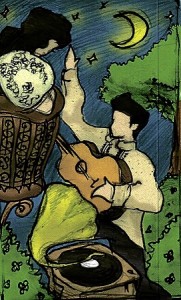
The first recorded song I ever heard when I was 4 or 5 years old was “Ang Bibingka” by Vicente Ocampo and Atang dela Rama. My yaya played the big breakable disc over and over on our 1930s crank-up phonograph. The iconic Atang dela Rama and the comedian, Vicente Ocampo, were vod-a-vil performers, and the song was terribly raunchy. It went like this:
Ang bibingka kung lutuin
Ay kaiba sa lahat
May apoy pa sa ilalim
May apoy pa sa itaas.
Si nanay at si tatay
Minsan ay nagkagalit
Dahil sa bibingkang
Ayaw daw ni tatay
Na malagkit
Ang bibingka etc.
Shirley
My mama was crazy about Shirley Temple. Like many moms of the era, she made scrapbooks of clippings of the precocious curly-mopped child star. My mother made me wear copies of her dresses which I hated because they were extremely short. The words of her most popular song go:
On the good ship, lollipop
It’s a sweet trip, to a candy shop
Where bonbons play
On the sunny beach of Peppermint Bay
Lemonade stands, everywhere
Crackerjack bands fill the air
Happy landing on a chocolate bar
I loved the song and saw many movies of Shirley with my mama and papa. I even own an autographed photo of her that my mother must have ordered from America.
‘Ibong Sawi’
Because I was hyperactive, even as I was growing up, my yaya from Cuenca, Batangas, would sing me a lullaby. She must have been homesick because she often spoke about her brother Igme and her sister Trining who told her Juan Tamad stories that she in turn related to me. The song she often sang was “Ako’y Isang Ibong Sawi.” It was so piteous and sad, it always made me cry. Eventually I would cover her mouth so she would not continue singing the song. Here are the lyrics:
Ako’y isang ibong sawi
Na hindi na makalipad
At sa puso’y may sugat
Wala pang lumingap
Inabot ng hatinggabi
Sa madilim na paglipad
Saan kaya ngayon
Ang aking pugad…
Other songs which had very sad melodies were for me “Dandansoy” and “Ili-ili Tulog Anay.”
‘Lubi Lubi’
Although my playmates were panggalatok, they liked singing “Lubi Lubi,” which is a Bicolano ditty that I learned from them. Most children then could sing “Lubi Lubi”:
Enero, Pebrero,
Marso, Abril, Mayo,
Hunyo, Hulyo, Agosto
Septyembre, Octubre,
Nobyembre, Disyembre
Lubi Lubi
Kon waray sin abaniko
Patay na ining lawas ko
Lawas ko, ay, ay!
Madidismayo
Sa balbas na dimasyado
For a long time I didn’t know what lubi lubi was until a plant grew in our garden called lubi lubi. Lubi means coconut and lubi lubi is a slim, 6-ft imitation coconut plant with serrated leaves and small inedible fruits that somewhat resemble coconuts.
‘Doon Po Sa Amin’
Although I learned a lot of English songs from school, it was always the Tagalog songs that stuck: “Bahay Kubo,” “Chichiritchit,” “Leron-Leron Sinta,” “Paru-parong Bukid,” “Awit ng Pulubi.” The latter is still one of my favorites. It goes:
I
Doon po sa amin
Bayan ng San Roque
May nagkatuwaang
Apat na pulubi
Nagsayaw ang pilay
Umawit ang pipi
Nanood ang bulag
Nakinig ang bingi
II
Doon po sa amin
Maralitang bayan
Nagkatay ng hayop
Niknik ang pangalan
Ang taba po nito
Nang maipatunaw
Ang nakuhang langis
Apat na tapayan
III
Doon po sa amin
Bayan ng Malabon
May isang matandang
Nagsaing ng apoy
Palayok ay papel
Papel pati tungtong
Tubig na malamig
Ang iginagatong.
Another favorite was “Leron-Leron Sinta,” specially its refrain that goes:
Ako’y ibigin mo
Lalaking matapang
Ang baril ko’y pito
Ang sundang ko’y siyam
Ang lalakarin ko’y
Parte ng dinulang
Isang pinggang pansit
Ang aking kalaban
‘Dungawin Mo Hirang’
There was a renaissance of Tagalog songs during the Japanese Occupation because singing English songs was banned. I was growing up and boys were beginning to notice me. In the rural areas, like where we evacuated, young swains made their intentions known by singing a harana (accompanied by a guitar) below the girl’s window.
If the suitor was welcome, he was asked to come upstairs. If unacceptable, the father of the girl threw water (or worse, urine from the chamberpot) at the singer. Here is the most common harana:
Irog ko’y pakinggan
Awit na mapanglaw
Na nagbuhat sa isang
Pusong nagmamahal
Hwag mong ipagkait
Puso ay ilawit
Sa abang puso kong
Naghihirap sa pagibig
Dungawin mo hirang
Ang nanambitan
Kahit sulyap mo
Man lamang
Iyong idampulay
Sa pagka’t ikaw lamang
Ang tanging dalanginan
Ng puso kong dahil
Sa iyo’y nabubuhay.
My father never opened window or door and we all pretended to be fast asleep. I just found everything so unbearably corny. Then I learned that my own father used to serenade girls in his youth! Since he didn’t sing or play the guitar, he would attach a radio (then a relatively new contraption) to the end of a long stick and raise it to the level of the girl’s window. Since his father was the town doctor and people knew that my papa was going to follow in those footsteps, no one, I’m sure, dared throw the contents of the chamberpot at him!









































